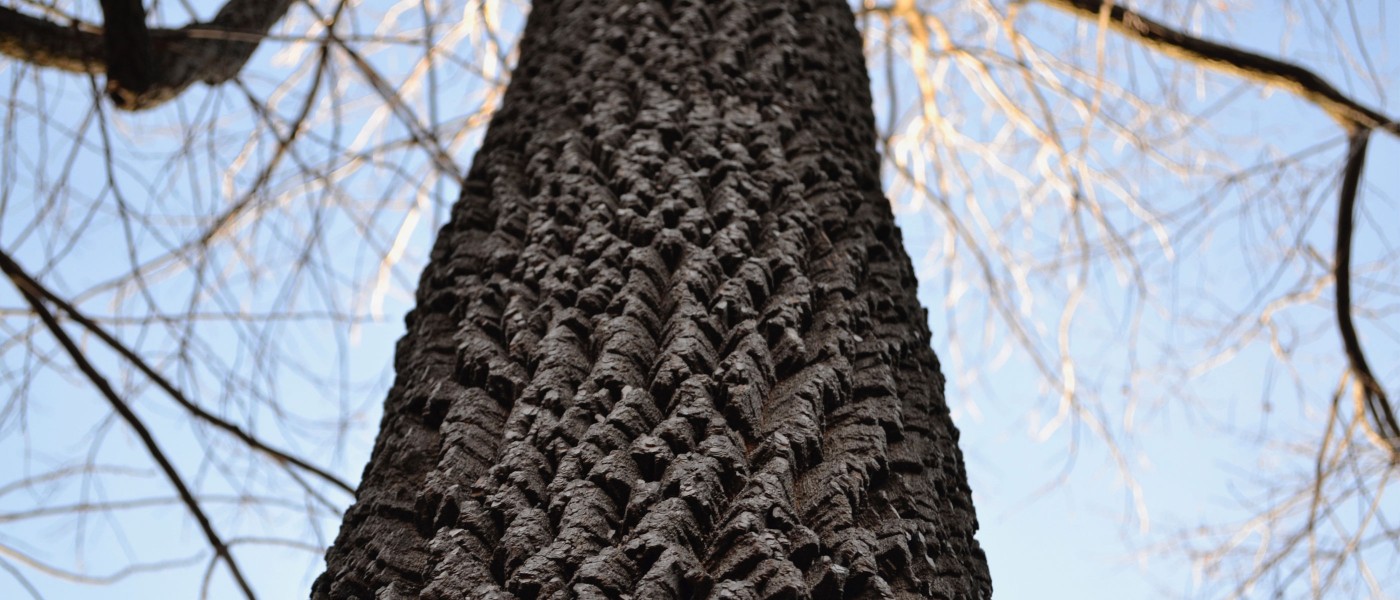Know These Trees by Their Bark
Wherever you live, wherever you tramp or travel, the trees of our country are wondrously companionable, if you have a speaking acquaintance with them.
—A Natural History of Trees, by Donald Culross Peattie
I can think of no better place in the city to develop “a speaking acquaintance” with trees than at Brooklyn Botanic Garden in the winter and no better way to do it than to look at the bark and bare forms of deciduous trees once their leaves have fallen. There are many different species and cultivars of trees at the Garden, and they are conveniently labeled, so you can even get on a first-name basis with them. Here's an introduction.
London Plane Tree(Platanus × acerifolia)
Celebrity Path
A common street and park tree in NYC, this tree, with its distinctive exfoliating bark, is a familiar sight to most New Yorkers. The specimens at BBG are older than many street trees and thus larger and more stately. The specimens growing along Celebrity Path make a dramatically pale silhouette against the winter sky.
(Acer palmatum ‘Dissectum’)
Shakespeare Garden, across from Japanese Hill-and-Pond Garden
Japanese maples in general have beautiful smooth, gray bark. The diminutive size of this particular specimen really allows the visitor to appreciate the overall effect of the naked bark along with its gracefully pruned form.
Japanese Flowering Cherry(Prunus pendula ‘Yae-Beni-Shidare’)
Near Tree Peony Collection
The cherry trees are all beautiful in the winter, with shiny bark, dotted with lenticels, and myriad variations: Some are smooth, some bumpy, some peeling, some not. This specimen stands out for its weeping habit and the light-gray, almost white color of its bark.
Magnolias (Magnolia species)Magnolia Plaza
Sure, the various species and cultivars on Magnolia Plaza are absolute showstoppers when they bloom in the spring, but in the winter, their aspect is rich and varied in a quieter way. Though the bark of magnolias is usually light colored and smooth, there are variations among different types, and discerning the variations is part of the delight of visiting. The moss and lichens covering some of the older specimens also decorate the trunk and limbs in lovely contrasting shapes and colors.
Paperbark Maple(Acer griseum)
Near Steinhardt Conservatory
The texture of this exfoliating bark—which peels off in layered sheets—would be a draw on its own. But wait, there’s more! The deep orange and red shades of this bark make it really special. When the winter light hits it just right, the trunk looks as if it's on fire. See it in person to get the full effect.
Crape-Myrtles (Lagerstroemia species)Various locations
Crape-myrtle, another tree with peeling bark, can be found all around the Garden. Various cultivars can be seen along the steps near the Lilac Collection; Lily Pool Terrace has several specimens of this small tree; and there are still more at the administrative entrance to the Garden at 1000 Washington Avenue. Though they all have mottled, peeling park, the colors vary from the whites and grays of L. ‘Muskogee’ to the rich red of ‘Natchez’.
Hardy Orange(Poncirus trifoliata ‘Flying Dragon’)
Near the Palm House
With its green bark, twisted branches, and long, scary-looking thorns, this tree seems like something out of a Tim Burton movie. The straight species, which can be seen near the Tropical Pavilion, has a looser, more open habit, and its older bark is a darker green with a braided appearance. The cultivar ‘Flying Dragon’, nearby, has greener stems and a smaller, more compact, twisted form.
Ginkgo (Ginkgo biloba)Ginkgo Allée, Overlook
Their trunks beautifully textured with chunky ridges, the mature specimens in the Garden’s stately Ginkgo Allée stand sentinel high over Cherry Esplanade. One of my favorite spots in the Garden at any time of year, it is especially dramatic in the wintertime. Some of the trees are also coated with green moss, and when the winter light hits the trunks, the white fissures between the ridges seem to glow with a light from within the tree itself.
Flame Willow(Salix alba ‘Flame’)
Water Garden
The bare stems of this shrub are red, orange-red, and yellow-orange, lending credence to its cultivar name. Unlike that of the similarly fiery-colored paperbark maple, the bark of this shrub is smooth rather than peeling.
Persimmon(Diospyros virginiana)
Near the Rose Arc Gate
The bark of our native persimmon has deep, uneven fissures in an irregular pattern of rectangular blocks, like the rough scales of some prehistoric lizard. The bark color can often be quite dark gray, almost black, but it can also be lighter shades of gray.
More: Winter Berries, Why Are You Still Here?
This is certainly not intended to be a comprehensive list of all the trees worth seeing at BBG in the winter. It’s an invitation to explore and discover your own favorites. Once you start noticing the wonderful world of tree bark and become better acquainted with the trees all around us, they will be more distinct living things, a vital part of the ecosystem of our beautiful city.


